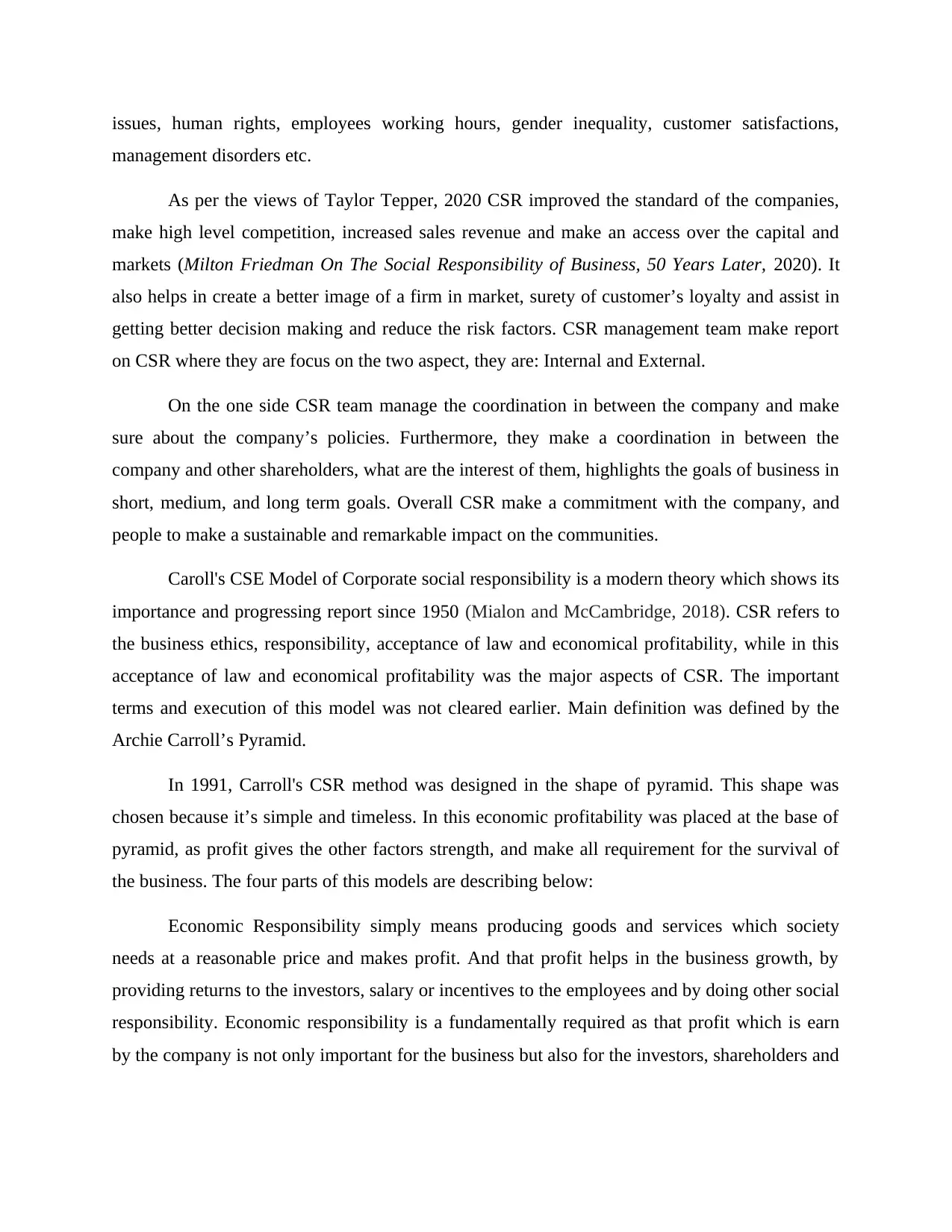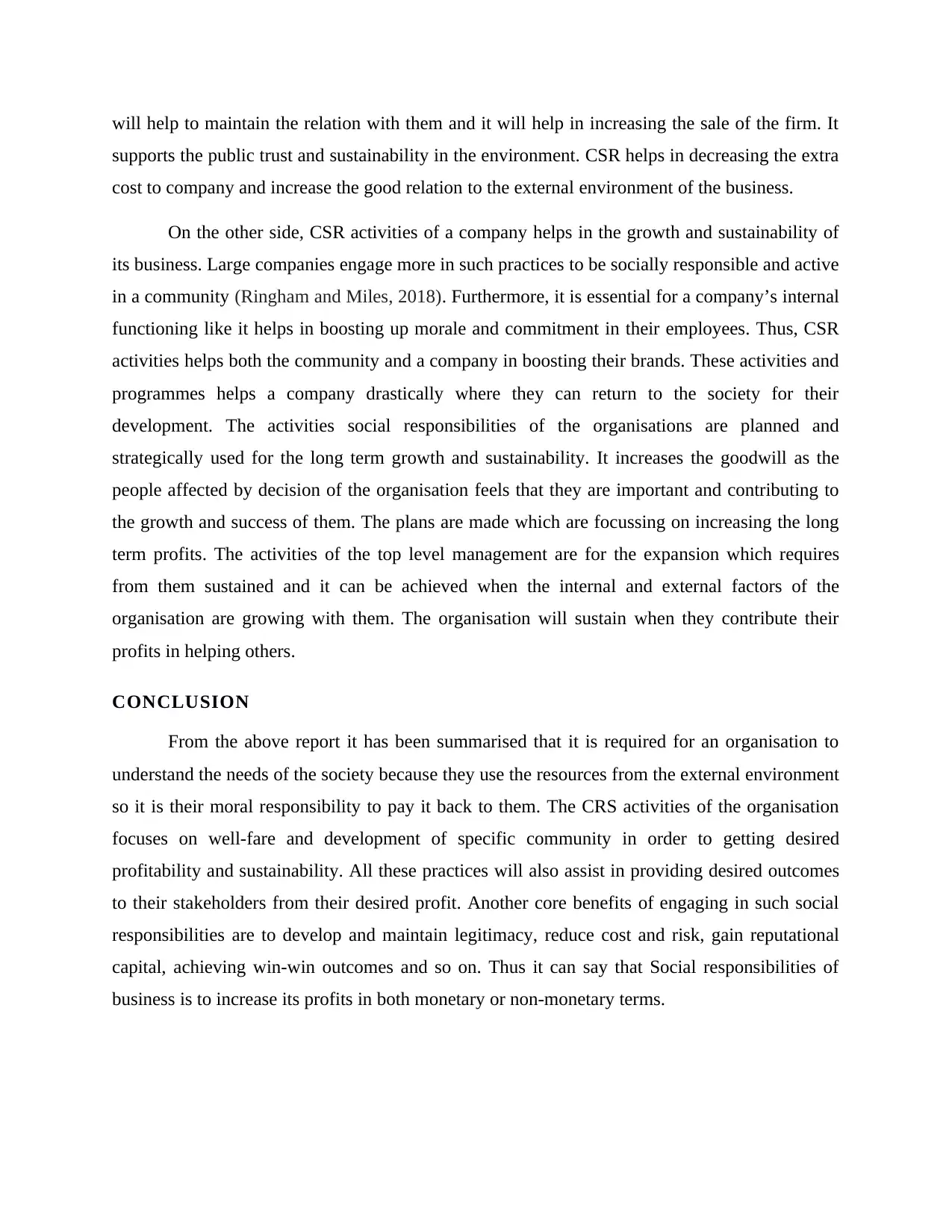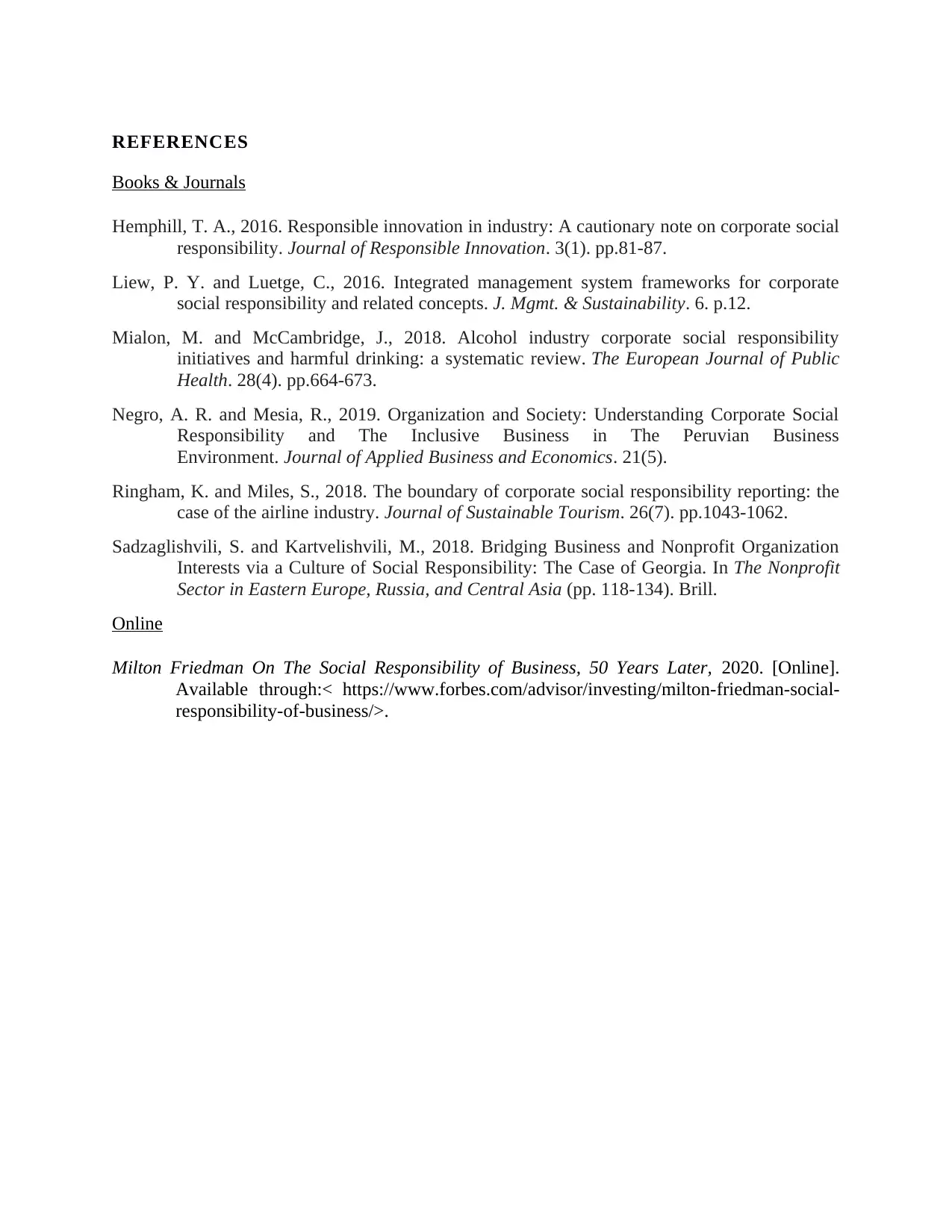Analyzing the Social Responsibility of Business and Profitability
VerifiedAdded on 2023/01/05
|7
|2002
|67
Essay
AI Summary
This essay examines the critical link between social responsibility and business profitability. It explores how businesses can leverage CSR initiatives to achieve higher profits and sustainable growth. The essay discusses the importance of stakeholder engagement, ethical business practices, and the implementation of various strategies to gain competitive advantages. It analyzes the impact of CSR on public perception, customer loyalty, and internal operations, citing examples of companies like Unilever and Apple. The essay also delves into Carroll's CSR model, outlining economic, legal, ethical, and philanthropic responsibilities. Furthermore, it highlights the monetary and non-monetary benefits of social responsibility, such as cost savings, improved employee morale, and increased market share. The conclusion reinforces the idea that businesses have a moral obligation to contribute to society while simultaneously enhancing their profitability and long-term sustainability. This comprehensive analysis provides valuable insights for students studying business development and related fields, with access to similar assignments available on Desklib.

Social Responsibility
of Business
of Business
Paraphrase This Document
Need a fresh take? Get an instant paraphrase of this document with our AI Paraphraser

TABLE OF CONTENTS
INTRODUCTION...............................................................................................................................................................3
MAIN BODY ....................................................................................................................................................................3
CONCLUSION...................................................................................................................................................................6
REFERENCES....................................................................................................................................................................7
INTRODUCTION...............................................................................................................................................................3
MAIN BODY ....................................................................................................................................................................3
CONCLUSION...................................................................................................................................................................6
REFERENCES....................................................................................................................................................................7

INTRODUCTION
In an economy, it is essential for an organisation to remain as an active player with the
help of their effective working practices (Hemphill, 2016). For this, it is required for them to
implement different strategies that can assist them to gain higher competitive advantages easily.
In such, one of the easiest way of earning desired profitability is to engage in social
responsibilities by uses all the resources effectively. Thus, this essay is going to determine the
how social responsibility of business is to increase its profit by considering views of different
authors as well as using different theories. These kind of practices will help in providing a
justification over the specific statement with the help of critiques.
MAIN BODY
For each and every organisation, it is required to analyse several areas of opportunities
that may help them in providing desired growth or success. In this, it is a responsibility of
business owner to evaluate their business objectives, important areas as well as growth strategies.
The most important responsibility of a business should be towards their stakeholders to provide
them desired returns (Liew and Luetge, 2016). In order to pay all the responsibilities properly, it
is required for a business to earn desired profit with the help of implementing all the strategic
directions. Thus, one of the appropriate way to earn competitive advantages and desired profit is
to engage in social responsibilities. Nowadays, several organisations engage in CSR practices
because it is a set of practices that organization uses to contribute to the well-being and safety of
their immediate community. Major example of this is Unilever, Bosch, P&G, Levi Strauss& Co.,
Apple, Cisco, IBM, Deloitte and so on. All these organisations provide their contribution in the
community welfare by providing an amount from their business profit. The act of these kind of
social responsibilities helps them to gain a desired sustainability, in earning positive public
attention, gaining customer loyalty and so on.
CSR is a management in which a company take care of the responsibility of social
responsibility and environmental issues. It is a broad area of responsibility where concern is
related to the shareholders, owners, customers and employees. CSR help in maintaining the
relations in between employees and corporation, boost up the morale of the employees and make
a connection between the internal staff and external environment. It also works on gender related
In an economy, it is essential for an organisation to remain as an active player with the
help of their effective working practices (Hemphill, 2016). For this, it is required for them to
implement different strategies that can assist them to gain higher competitive advantages easily.
In such, one of the easiest way of earning desired profitability is to engage in social
responsibilities by uses all the resources effectively. Thus, this essay is going to determine the
how social responsibility of business is to increase its profit by considering views of different
authors as well as using different theories. These kind of practices will help in providing a
justification over the specific statement with the help of critiques.
MAIN BODY
For each and every organisation, it is required to analyse several areas of opportunities
that may help them in providing desired growth or success. In this, it is a responsibility of
business owner to evaluate their business objectives, important areas as well as growth strategies.
The most important responsibility of a business should be towards their stakeholders to provide
them desired returns (Liew and Luetge, 2016). In order to pay all the responsibilities properly, it
is required for a business to earn desired profit with the help of implementing all the strategic
directions. Thus, one of the appropriate way to earn competitive advantages and desired profit is
to engage in social responsibilities. Nowadays, several organisations engage in CSR practices
because it is a set of practices that organization uses to contribute to the well-being and safety of
their immediate community. Major example of this is Unilever, Bosch, P&G, Levi Strauss& Co.,
Apple, Cisco, IBM, Deloitte and so on. All these organisations provide their contribution in the
community welfare by providing an amount from their business profit. The act of these kind of
social responsibilities helps them to gain a desired sustainability, in earning positive public
attention, gaining customer loyalty and so on.
CSR is a management in which a company take care of the responsibility of social
responsibility and environmental issues. It is a broad area of responsibility where concern is
related to the shareholders, owners, customers and employees. CSR help in maintaining the
relations in between employees and corporation, boost up the morale of the employees and make
a connection between the internal staff and external environment. It also works on gender related
⊘ This is a preview!⊘
Do you want full access?
Subscribe today to unlock all pages.

Trusted by 1+ million students worldwide

issues, human rights, employees working hours, gender inequality, customer satisfactions,
management disorders etc.
As per the views of Taylor Tepper, 2020 CSR improved the standard of the companies,
make high level competition, increased sales revenue and make an access over the capital and
markets (Milton Friedman On The Social Responsibility of Business, 50 Years Later, 2020). It
also helps in create a better image of a firm in market, surety of customer’s loyalty and assist in
getting better decision making and reduce the risk factors. CSR management team make report
on CSR where they are focus on the two aspect, they are: Internal and External.
On the one side CSR team manage the coordination in between the company and make
sure about the company’s policies. Furthermore, they make a coordination in between the
company and other shareholders, what are the interest of them, highlights the goals of business in
short, medium, and long term goals. Overall CSR make a commitment with the company, and
people to make a sustainable and remarkable impact on the communities.
Caroll's CSE Model of Corporate social responsibility is a modern theory which shows its
importance and progressing report since 1950 (Mialon and McCambridge, 2018). CSR refers to
the business ethics, responsibility, acceptance of law and economical profitability, while in this
acceptance of law and economical profitability was the major aspects of CSR. The important
terms and execution of this model was not cleared earlier. Main definition was defined by the
Archie Carroll’s Pyramid.
In 1991, Carroll's CSR method was designed in the shape of pyramid. This shape was
chosen because it’s simple and timeless. In this economic profitability was placed at the base of
pyramid, as profit gives the other factors strength, and make all requirement for the survival of
the business. The four parts of this models are describing below:
Economic Responsibility simply means producing goods and services which society
needs at a reasonable price and makes profit. And that profit helps in the business growth, by
providing returns to the investors, salary or incentives to the employees and by doing other social
responsibility. Economic responsibility is a fundamentally required as that profit which is earn
by the company is not only important for the business but also for the investors, shareholders and
management disorders etc.
As per the views of Taylor Tepper, 2020 CSR improved the standard of the companies,
make high level competition, increased sales revenue and make an access over the capital and
markets (Milton Friedman On The Social Responsibility of Business, 50 Years Later, 2020). It
also helps in create a better image of a firm in market, surety of customer’s loyalty and assist in
getting better decision making and reduce the risk factors. CSR management team make report
on CSR where they are focus on the two aspect, they are: Internal and External.
On the one side CSR team manage the coordination in between the company and make
sure about the company’s policies. Furthermore, they make a coordination in between the
company and other shareholders, what are the interest of them, highlights the goals of business in
short, medium, and long term goals. Overall CSR make a commitment with the company, and
people to make a sustainable and remarkable impact on the communities.
Caroll's CSE Model of Corporate social responsibility is a modern theory which shows its
importance and progressing report since 1950 (Mialon and McCambridge, 2018). CSR refers to
the business ethics, responsibility, acceptance of law and economical profitability, while in this
acceptance of law and economical profitability was the major aspects of CSR. The important
terms and execution of this model was not cleared earlier. Main definition was defined by the
Archie Carroll’s Pyramid.
In 1991, Carroll's CSR method was designed in the shape of pyramid. This shape was
chosen because it’s simple and timeless. In this economic profitability was placed at the base of
pyramid, as profit gives the other factors strength, and make all requirement for the survival of
the business. The four parts of this models are describing below:
Economic Responsibility simply means producing goods and services which society
needs at a reasonable price and makes profit. And that profit helps in the business growth, by
providing returns to the investors, salary or incentives to the employees and by doing other social
responsibility. Economic responsibility is a fundamentally required as that profit which is earn
by the company is not only important for the business but also for the investors, shareholders and
Paraphrase This Document
Need a fresh take? Get an instant paraphrase of this document with our AI Paraphraser

for the business growth. Actually that's the foundation of the pyramid on which others layer are
depends.
Legal Responsibility is the second stage of this pyramid is to fulfil legal obligations to
obey the law. This stage shows the company responsibility towards the legislators on national,
state, and district level. How a company conduct their businesses in the market place. This
includes tax regulations, legal formulations related to the environment and business, employee's
health and basic satisfaction, providing goods and services to the customer.
Ethical Responsibility at the third stage includes to act morally and ethically. This acts
are responsible for norms, regulations, standard, business ethics and rules which are actually
related to customers, investors, owners, and employees (Negro and Mesia, 2019). Legal
responsibility is somehow based on ethical values, so it can be concluding that there is no
difference in between legal and ethical responsibility.
Philanthropic Responsibility is the last stage of this pyramid, it includes what actually
business is given to society. This includes the voluntary and discretionary activities done by
business. In order to fulfil this responsibility business gives back to their employees, owner and
customers in terms of gifts, incentives, voluntary work, donations, and social work contribution
in the society.
On the basis of above analysis, it has been analysed that social responsibilities of an
organisation assist in providing monetary and growth sustainable opportunities as:
In respect of monetary terms, social responsibility helps a business to earn more profits.
As CSR aid in achieving the social goals in the environment, as well as it helps in earning
desired sustainability. It provides the various solution by which a company can easily expand its
market share. In respect of environmental consideration, CSR saves the cost of the company by
avoiding waste materials from the production cost. By doing this they can save their utility bills
and use that money in the other sector (Sadzaglishvili and Kartvelishvili, 2018). CSR also help in
recruiting the employees, that helps in maximising business productivity in direct manner. Other
benefits that can help the business is they provide access in budget and maintain the
advertisement cost. CSR help in identifying the new business opportunities which will increase
the profit of the company directly. When there is a good customer relation with the company it
depends.
Legal Responsibility is the second stage of this pyramid is to fulfil legal obligations to
obey the law. This stage shows the company responsibility towards the legislators on national,
state, and district level. How a company conduct their businesses in the market place. This
includes tax regulations, legal formulations related to the environment and business, employee's
health and basic satisfaction, providing goods and services to the customer.
Ethical Responsibility at the third stage includes to act morally and ethically. This acts
are responsible for norms, regulations, standard, business ethics and rules which are actually
related to customers, investors, owners, and employees (Negro and Mesia, 2019). Legal
responsibility is somehow based on ethical values, so it can be concluding that there is no
difference in between legal and ethical responsibility.
Philanthropic Responsibility is the last stage of this pyramid, it includes what actually
business is given to society. This includes the voluntary and discretionary activities done by
business. In order to fulfil this responsibility business gives back to their employees, owner and
customers in terms of gifts, incentives, voluntary work, donations, and social work contribution
in the society.
On the basis of above analysis, it has been analysed that social responsibilities of an
organisation assist in providing monetary and growth sustainable opportunities as:
In respect of monetary terms, social responsibility helps a business to earn more profits.
As CSR aid in achieving the social goals in the environment, as well as it helps in earning
desired sustainability. It provides the various solution by which a company can easily expand its
market share. In respect of environmental consideration, CSR saves the cost of the company by
avoiding waste materials from the production cost. By doing this they can save their utility bills
and use that money in the other sector (Sadzaglishvili and Kartvelishvili, 2018). CSR also help in
recruiting the employees, that helps in maximising business productivity in direct manner. Other
benefits that can help the business is they provide access in budget and maintain the
advertisement cost. CSR help in identifying the new business opportunities which will increase
the profit of the company directly. When there is a good customer relation with the company it

will help to maintain the relation with them and it will help in increasing the sale of the firm. It
supports the public trust and sustainability in the environment. CSR helps in decreasing the extra
cost to company and increase the good relation to the external environment of the business.
On the other side, CSR activities of a company helps in the growth and sustainability of
its business. Large companies engage more in such practices to be socially responsible and active
in a community (Ringham and Miles, 2018). Furthermore, it is essential for a company’s internal
functioning like it helps in boosting up morale and commitment in their employees. Thus, CSR
activities helps both the community and a company in boosting their brands. These activities and
programmes helps a company drastically where they can return to the society for their
development. The activities social responsibilities of the organisations are planned and
strategically used for the long term growth and sustainability. It increases the goodwill as the
people affected by decision of the organisation feels that they are important and contributing to
the growth and success of them. The plans are made which are focussing on increasing the long
term profits. The activities of the top level management are for the expansion which requires
from them sustained and it can be achieved when the internal and external factors of the
organisation are growing with them. The organisation will sustain when they contribute their
profits in helping others.
CONCLUSION
From the above report it has been summarised that it is required for an organisation to
understand the needs of the society because they use the resources from the external environment
so it is their moral responsibility to pay it back to them. The CRS activities of the organisation
focuses on well-fare and development of specific community in order to getting desired
profitability and sustainability. All these practices will also assist in providing desired outcomes
to their stakeholders from their desired profit. Another core benefits of engaging in such social
responsibilities are to develop and maintain legitimacy, reduce cost and risk, gain reputational
capital, achieving win-win outcomes and so on. Thus it can say that Social responsibilities of
business is to increase its profits in both monetary or non-monetary terms.
supports the public trust and sustainability in the environment. CSR helps in decreasing the extra
cost to company and increase the good relation to the external environment of the business.
On the other side, CSR activities of a company helps in the growth and sustainability of
its business. Large companies engage more in such practices to be socially responsible and active
in a community (Ringham and Miles, 2018). Furthermore, it is essential for a company’s internal
functioning like it helps in boosting up morale and commitment in their employees. Thus, CSR
activities helps both the community and a company in boosting their brands. These activities and
programmes helps a company drastically where they can return to the society for their
development. The activities social responsibilities of the organisations are planned and
strategically used for the long term growth and sustainability. It increases the goodwill as the
people affected by decision of the organisation feels that they are important and contributing to
the growth and success of them. The plans are made which are focussing on increasing the long
term profits. The activities of the top level management are for the expansion which requires
from them sustained and it can be achieved when the internal and external factors of the
organisation are growing with them. The organisation will sustain when they contribute their
profits in helping others.
CONCLUSION
From the above report it has been summarised that it is required for an organisation to
understand the needs of the society because they use the resources from the external environment
so it is their moral responsibility to pay it back to them. The CRS activities of the organisation
focuses on well-fare and development of specific community in order to getting desired
profitability and sustainability. All these practices will also assist in providing desired outcomes
to their stakeholders from their desired profit. Another core benefits of engaging in such social
responsibilities are to develop and maintain legitimacy, reduce cost and risk, gain reputational
capital, achieving win-win outcomes and so on. Thus it can say that Social responsibilities of
business is to increase its profits in both monetary or non-monetary terms.
⊘ This is a preview!⊘
Do you want full access?
Subscribe today to unlock all pages.

Trusted by 1+ million students worldwide

REFERENCES
Books & Journals
Hemphill, T. A., 2016. Responsible innovation in industry: A cautionary note on corporate social
responsibility. Journal of Responsible Innovation. 3(1). pp.81-87.
Liew, P. Y. and Luetge, C., 2016. Integrated management system frameworks for corporate
social responsibility and related concepts. J. Mgmt. & Sustainability. 6. p.12.
Mialon, M. and McCambridge, J., 2018. Alcohol industry corporate social responsibility
initiatives and harmful drinking: a systematic review. The European Journal of Public
Health. 28(4). pp.664-673.
Negro, A. R. and Mesia, R., 2019. Organization and Society: Understanding Corporate Social
Responsibility and The Inclusive Business in The Peruvian Business
Environment. Journal of Applied Business and Economics. 21(5).
Ringham, K. and Miles, S., 2018. The boundary of corporate social responsibility reporting: the
case of the airline industry. Journal of Sustainable Tourism. 26(7). pp.1043-1062.
Sadzaglishvili, S. and Kartvelishvili, M., 2018. Bridging Business and Nonprofit Organization
Interests via a Culture of Social Responsibility: The Case of Georgia. In The Nonprofit
Sector in Eastern Europe, Russia, and Central Asia (pp. 118-134). Brill.
Online
Milton Friedman On The Social Responsibility of Business, 50 Years Later, 2020. [Online].
Available through:< https://www.forbes.com/advisor/investing/milton-friedman-social-
responsibility-of-business/>.
Books & Journals
Hemphill, T. A., 2016. Responsible innovation in industry: A cautionary note on corporate social
responsibility. Journal of Responsible Innovation. 3(1). pp.81-87.
Liew, P. Y. and Luetge, C., 2016. Integrated management system frameworks for corporate
social responsibility and related concepts. J. Mgmt. & Sustainability. 6. p.12.
Mialon, M. and McCambridge, J., 2018. Alcohol industry corporate social responsibility
initiatives and harmful drinking: a systematic review. The European Journal of Public
Health. 28(4). pp.664-673.
Negro, A. R. and Mesia, R., 2019. Organization and Society: Understanding Corporate Social
Responsibility and The Inclusive Business in The Peruvian Business
Environment. Journal of Applied Business and Economics. 21(5).
Ringham, K. and Miles, S., 2018. The boundary of corporate social responsibility reporting: the
case of the airline industry. Journal of Sustainable Tourism. 26(7). pp.1043-1062.
Sadzaglishvili, S. and Kartvelishvili, M., 2018. Bridging Business and Nonprofit Organization
Interests via a Culture of Social Responsibility: The Case of Georgia. In The Nonprofit
Sector in Eastern Europe, Russia, and Central Asia (pp. 118-134). Brill.
Online
Milton Friedman On The Social Responsibility of Business, 50 Years Later, 2020. [Online].
Available through:< https://www.forbes.com/advisor/investing/milton-friedman-social-
responsibility-of-business/>.
1 out of 7
Related Documents
Your All-in-One AI-Powered Toolkit for Academic Success.
+13062052269
info@desklib.com
Available 24*7 on WhatsApp / Email
![[object Object]](/_next/static/media/star-bottom.7253800d.svg)
Unlock your academic potential
Copyright © 2020–2025 A2Z Services. All Rights Reserved. Developed and managed by ZUCOL.



